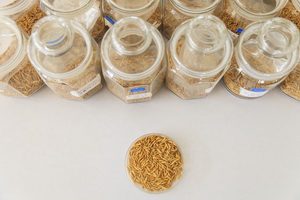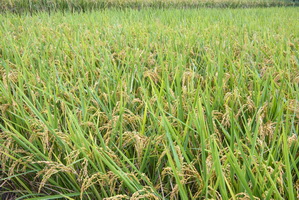CROP BIOTECH UPDATE
---------------------------------------------------------------------------
A weekly summary of world developments in agri-biotech for developing countries, produced by the Global Knowledge Center on Crop Biotechnology, International Service for the Acquisition of Agri-biotech Applications SEAsiaCenter (ISAAA)
---------------------------------------------------------------------------
April 24, 2019
In This Week’s Issue:
News
Global
Scientists Race to Save Bananas from Panama Disease
Researchers Use Order Theory to Show the Connection Between CO2 Emission and GM Crops
Asia and the Pacific
Scientists Discover Ways to Regenerate Plant Tissues
Japanese Health Ministry Finalizes Policy on Genome-Edited Food Products
Australian OGTR Grants Permit to GM Wheat Field Trial
Europe
Knowing How Cells Grow and Divide Leads to More Robust and Productive Plants
Research
LncRNA Controls Susceptibility to Cry1Ac in Pink Bollworm
Salt Tolerant Rice Variety Developed in India
New Breeding Technologies
Simple Method for Rapid Screening of CRISPR-Cas9-Induced Mutants
Experts Release Protocol for Creating Large Chromosomal Deletions in Rice Using CRISPR-Cas9
Beyond Crop Biotech
NTU Researchers Genetically Modify Key Protein in Plants to Increase Seed Oil Yield
Scientists Explore Consumer Response to Health Information Campaigns and Genetically Modified Food Labels
Announcements
CRISPRcon 2019
CBU Subscriber Survey
----
NEWS
----
Global
SCIENTISTS RACE TO SAVE BANANAS FROM PANAMA DISEASE
Since its discovery in the 1800s, Fusarium Wilt or Panama disease has been a global threat to the banana industry, wiping out entire plantations in Asia, Australia, Middle East, Africa, and Latin America. The economic impact of the disease has been catastrophic, with losses reaching US$18.2 billion to date.
One of the major breakthroughs in the industry was the discovery of another variety of banana, known as the Cavendish. This variety was almost entirely resistant to Panama disease. Currently, 99% of exported bananas and about half of the total production worldwide are Cavendish bananas. However, the Panama disease has made a comeback, and not even the Cavendish is immune.
Scientists now turn to modern biotechnology to create a new plant resistant to Panama disease. Genetic modification in particular, is seen as a possible solution to protect the plants from Tropical Race 4 or TR4, the strain of fungus that appeared in Taiwan in the early 2000s.
For instance, researchers from Australia have discovered that adding two different genes from a wild banana resistant to TR4 and another one from nematode worms to the genetic code of Cavendish bananas protects the plants from TR4. Meanwhile, a team from Taiwan has already produced a Cavendish line which can somewhat withstand TR4. Another study shows evidence that some crops can defend bananas against TR4.
For more details, read the news article in The Conversation.
RESEARCHERS USE ORDER THEORY TO SHOW THE CONNECTION BETWEEN CO2 EMISSION AND GM CROPS
 Genetic modification (GM) and climate change are two ecological issues that are highly debated globally. GM crops is one of the proposed solutions in decreasing the impacts of agricultural processes on the environment and to increase production as well. In 2017, 27 countries have planted GM crops.
Genetic modification (GM) and climate change are two ecological issues that are highly debated globally. GM crops is one of the proposed solutions in decreasing the impacts of agricultural processes on the environment and to increase production as well. In 2017, 27 countries have planted GM crops.
Nancy Y. Quintero and Isaac Cohen from Universidad de Pamplona (Colombia) and Universidad Tecnolσgica Nacional (Argentina), respectively, released an article to give insights about the possible linkages between the cultivated areas and the CO2 emissions in the GM-adopting countries. They also aimed to establish meaningful connections between attributes related to socio-economic situations and the environmental impacts of GM crops. To give mathematical support to such links, they used the methodology called Order Theory, which tackles binary relations in analysis.
Results showed that Paraguay, India, Burkina Faso, Brazil, and Pakistan could play the biggest role in mitigating climate change through decrease in CO2 emission levels using GM crops.
Read more findings in Environmental Modeling & Assessment.
Asia and the Pacific
SCIENTISTS DISCOVER WAYS TO REGENERATE PLANT TISSUES
Scientists from Tokyo University of Science have discovered a new way to regenerate plant tissues. Plant regeneration occurs through the formation of a mass of pluripotent cells. Pluripotency involves silencing genes to remove original tissue memory and priming for activation by external input. The scientists, led by Professor Sachihiro Matsunaga have shown that plant regenerative capacity requires a certain demethylase that can prime gene expression in response to regenerative cues.
Using Arabidopsis thaliana, Professor Matsunaga and his team studied genome-wide histone modifications. Histones are proteins that package together eukaryotic DNA, preventing it from being transcribed or decoded. Upon modification, however, these proteins' grasp around the DNA molecule loosens, making it easier for the DNA to be transcribed. The scientists found that it is the demethylation (the removal of a methyl group from the amino acid) of the histone H3 by the LDL3 enzyme that lends regenerative competency to the plant. This epigenetic mechanism allows the plant's pluripotent cells to go back to its unipotent state and thus assume the identity of shoot meristems for differentiated tissues including leaves and stems.
For more details, read the news article from Tokyo University of Science.
JAPANESE HEALTH MINISTRY FINALIZES POLICY ON GENOME-EDITED FOOD PRODUCTS
The Ministry of Health, Labor and Welfare (MHLW) of Japan has released its regulatory policy for handling food products derived from genome editing technology on March 27, 2019. The policy establishes conditions for when genome-edited products will be regulated and when they will not.
The final regulatory policy is derived from the proposed policy reviewed for its validity by the Research Committee for Newly Developed Food in MHLW in February this year. The summary of the policy includes points of deliberation, handling of foods from genome-edited technology from the perspective of food hygiene, handling of food additives derived from genome-edited organisms, risk communication for the public, and the refinements needed as the technology develops.
For more details about the policy, read the US FAS GAIN Report.
AUSTRALIAN OGTR GRANTS PERMIT TO GM WHEAT FIELD TRIAL
 Australia's Office of the Gene Technology Regulator (OGTR) has issued license DIR 165 to the University of Melbourne for the limited and controlled release (field trial) of wheat genetically modified (GM) for altered iron uptake, transport, and bioavailability.
Australia's Office of the Gene Technology Regulator (OGTR) has issued license DIR 165 to the University of Melbourne for the limited and controlled release (field trial) of wheat genetically modified (GM) for altered iron uptake, transport, and bioavailability.
The field trial will take place between April 2019 and December 2023 at sites in New South Wales, Victoria, and Western Australia. In the first year, the field trial will be conducted at up to two trial sites, with a maximum combined area of 4 hectares. In the remaining four years, the field trial will be conducted at up to 10 trial sites per year, with a maximum combined area of 20 hectares per year. It will gather research and regulatory data under field conditions. The GM wheat grown in the field trial will not be used in human food or animal feed.
The Risk Assessment and Risk Management Plan (RARMP) and the license were finalized from input received during consultation with the public, State and Territory governments, Australian Government agencies, the Minister for the Environment, the Gene Technology Technical Advisory Committee and local councils.
The finalized RARMP, a summary of the RARMP, a set of Questions and Answers on this decision and a copy of the license, are available online from the DIR 165 page in the OGTR website.
Europe
KNOWING HOW CELLS GROW AND DIVIDE LEADS TO MORE ROBUST AND PRODUCTIVE PLANTS
Research teams from VIB-UGent Center for Plant Systems Biology (Belgium), the University of Nottingham (UK), Heidelberg University (Germany), and the University of Copenhagen (Denmark) have identified a novel component that controls the development of root branches supporting plants.
The teams looked at how plants deal with changing environments specifically with temperature extremes and drought stress, and explored how (lateral) roots evolved and developed. To investigate organ formation in plants, the research teams used root branching as their model system and discovered a new component through which plants control the process.
The researchers explored which genes are expressed during the early stages of the process, leading to the identification of a cell wall modifying enzyme a molecule that regulates chemical reactions that controls the cell divisions leading to the growth of a new root. They found that mutations in the gene that codes for this enzyme led to swelling of root cells that give rise to a new lateral root and resulted in subsequent defects in the first asymmetric cell divisions during the formation of root branches.
For more details, read the news article at the VIB website.
Research
LNCRNA CONTROLS SUSCEPTIBILITY TO CRY1AC IN PINK BOLLWORM
The extensive planting of insect resistant crops expressing Bt proteins contributed to the evolution of resistance in pests as a natural reaction. The globally destructive pest pink bollworm's resistance to Bt protein Cry1Ac is linked with mutations in PgCad1 gene, which encodes a cadherin protein that sticks with Cry1Ac in the larval midgut. In a previous study, Shenyun Li from Nanjing Agricultural University in China, together with other scientists, reported a long non-coding RNA (lncRNA) which is linked with both resistance and susceptibility to Cry1Ac. In their latest study, they tested the hypothesis that decreasing the expression of the lncRNA also reduces the transcription of PgCad1 and susceptibility to Cry1Ac. The results are published in Pesticide Biochemistry and Physiology.
Results of the Quantitative RT-PCR showed that feeding susceptible pink bollworm neonates with small interfering RNAs (siRNAs) targeting this lncRNA but not PgCad1 decreased the abundance of transcripts of both the lncRNA and PgCad1. Furthermore, neonates fed with siRNA showed decreased susceptibility to Cry1Ac. These findings imply that the lncRNA increases transcription PgCad1 and susceptibility of pink bollworm to Cry1Ac.
Read the research article in Pesticide Biochemistry and Physiology.
SALT TOLERANT RICE VARIETY DEVELOPED IN INDIA
 Scientists from Bose Institute in Kolkata, India developed a salt tolerant transgenic rice variety which, under greenhouse conditions, showed normal growth and grain yield.
Scientists from Bose Institute in Kolkata, India developed a salt tolerant transgenic rice variety which, under greenhouse conditions, showed normal growth and grain yield.
The scientists used genes from the wild rice species Porteresia coarctata. This species, native to some parts of South Asia, is known to be a halophyte, thus a rich source of salt stress tolerance genes. They were able to identify a gene, PcINO1, that codes for a salt-tolerant enzyme that synthesizes inositol even in the presence of salt. Inositol is a vitamin-like substance that acts as a stress-ameliorator and a switch to pathways important for communicating salt tolerance. By overexpressing PcINO1 into the commonly used IR64 indica rice variety, they developed a new variety that can withstand up to 200mcmol per Li of salt, or about half as saline as seawater. According to the head scientist, this may also indicate that the manipulation of inositol metabolic pathway may be one way to combat salt stress in plants.
The significance of the new findings is important to the development of plant varieties that can survive salinity and drought as concerns and discussions about global climate change become more apparent.
Read the full article in Scientific Reports.
New Breeding Technologies
SIMPLE METHOD FOR RAPID SCREENING OF CRISPR-CAS9-INDUCED MUTANTS
The clustered regularly interspaced short palindromic repeats-CRISPR-associated protein 9 (CRISPR-Cas9) system is considered as a technological revolution in targeted mutagenesis. However, a large amount of time and cost is needed to screen for the CRISPR-Cas9 induced mutants from a usual large number of initial samples. Thus, Chun Wang and Kejian Wang from the Chinese Academy of Agricultural Sciences presented a cost-effective and sensitive screening technique for identifying mutants based on conventional polymerase chain reaction (PCR). They called this new technique as annealing at critical temperature PCR (ACT-PCR).
ACT-PCR needs only one PCR step and then execution of agarose gel electrophoresis. Because of its simplicity, ACT-PCR is suitable for rapid, large-scale screening of CRISPR-Cas9-induced mutants.
Read more description about ACT-PCR in Plant Genome Editing with CRISPR Systems.
EXPERTS RELEASE PROTOCOL FOR CREATING LARGE CHROMOSOMAL DELETIONS IN RICE USING CRISPR-CAS9
 Engineered CRISPR-Cas9 has become the most popular and efficient tool used in genome engineering plants, particularly crops. Researchers have successfully introduced mutations in several genes at the same time, develop conditional variants of genes, and generate tagged proteins originated from within organisms. Thus, the CRISPR-Cas9 system is highly important in enhancing the performance of crop plants particularly in increasing the yield, improving the nutritional content, and developing better tolerance to biotic and abiotic stresses. Aside from these benefits, the system has shown to be highly effective in creating large chromosomal deletions in plants, which is useful for genetic analysis of chromosomal fragments, functional study of gene clusters in biological processes, etc.
Engineered CRISPR-Cas9 has become the most popular and efficient tool used in genome engineering plants, particularly crops. Researchers have successfully introduced mutations in several genes at the same time, develop conditional variants of genes, and generate tagged proteins originated from within organisms. Thus, the CRISPR-Cas9 system is highly important in enhancing the performance of crop plants particularly in increasing the yield, improving the nutritional content, and developing better tolerance to biotic and abiotic stresses. Aside from these benefits, the system has shown to be highly effective in creating large chromosomal deletions in plants, which is useful for genetic analysis of chromosomal fragments, functional study of gene clusters in biological processes, etc.
Scientist Riqing Li and colleagues from Iowa State University in the USA presented a new protocol that can be used in creating large chromosomal deletions in rice using the CRISPR-Cas9 system. Detailed information about single-guide RNA design, vector construction, plant transformation, and large deletion screening processes in rice were also discussed.
For more details, download the whole chapter on Creating Large Chromosomal Deletions in Rice Using CRISPR-Cas9 from the book Plant Genome Editing with CRISPR Systems.
Beyond Crop Biotech
NTU RESEARCHERS GENETICALLY MODIFY KEY PROTEIN IN PLANTS TO INCREASE SEED OIL YIELD
Scientists at Nanyang Technological University, Singapore (NTU Singapore) have developed a sustainable way to increase the natural oil in seeds by up to 15 percent in laboratory conditions.
The team, led by Assistant Professor Wei Ma genetically modified a key protein in plants which regulates the amount of oil they produce, resulting in larger oil reserves in the seed that primarily serves as an energy source for germination. The team's discovery which has a pending patent involves the protein known as "Wrinkled1" or "WRI1", which regulates plants' oil production. After modification, the seeds have a wrinkled appearance, which is the basis for its name.
This method has applications to other crops such as canola, soybean, and sunflower. The increased yield in seed oil also benefits the production of biofuels, according to Professor Ma.
For more details, read the news article at the NTU Singapore website.
SCIENTISTS EXPLORE CONSUMER RESPONSE TO HEALTH INFORMATION CAMPAIGNS AND GENETICALLY MODIFIED FOOD LABELS
Scientist Michael Weir from the University of Rhode Island (URI) conducted a study to investigate consumer responses to two forms of information provision in the seafood market: health information campaigns and GM food labels. The paper is published in URI's Open Access Dissertations.
Using information from a seafood auction experiment, Weir explored the sources of differences in the responses of the auction participants to health information in the context of current US Departments of Agriculture and Health and Human Services policy goals using a mixed effects finite mixture model. He also explored the potential effect of the National Bioengineered Food Disclosure Standard on seafood demand.
Two distinct groups of consumers were identified: the "trust academics", wherein most of the sample fall under; and the "specialty store shoppers", who significantly respond to seafood health risk campaigns. The trust academics group is receptive to both risk- and benefit-focused information campaigns. The specialty store shoppers trust the information provided by social influences.
Read more results in URI's Open Access Dissertations.
Announcements
CRISPRCON 2019
What: CRISPRcon 2019: Conversations on Science, Society and the Future of Gene Editing
Where: Wageningen, The Netherlands
When: June 20-21, 2019
For more details including registration, agenda, and speakers, visit the CRISPRcon 2019 event page.
CBU SUBSCRIBER SURVEY
Dear Crop Biotech Update (CBU) Subscriber,
We would like to request for your feedback regarding our e-newsletter, the Crop Biotech Update. We value your comments and suggestions to further improve our service. Please take a few minutes of your time to answer this very short questionnaire.
Do you also use the ISAAA GM Approval Database and ISAAA Annual Brief on GM crop adoption? If yes, it would be a great help if you also take the following surveys:
GM Approval Database User Survey | ISAAA Annual Report Survey
Thank you for your continuing support and we look forward to receiving your feedback on or before April 26, 2019.
Sincerely,
CBU Team
(c) 2024. ISAAA.
 Genetic modification (GM) and climate change are two ecological issues that are highly debated globally. GM crops is one of the proposed solutions in decreasing the impacts of agricultural processes on the environment and to increase production as well. In 2017, 27 countries have planted GM crops.
Genetic modification (GM) and climate change are two ecological issues that are highly debated globally. GM crops is one of the proposed solutions in decreasing the impacts of agricultural processes on the environment and to increase production as well. In 2017, 27 countries have planted GM crops.  Australia's Office of the Gene Technology Regulator (OGTR) has issued license DIR 165 to the University of Melbourne for the limited and controlled release (field trial) of wheat
Australia's Office of the Gene Technology Regulator (OGTR) has issued license DIR 165 to the University of Melbourne for the limited and controlled release (field trial) of wheat  Scientists from Bose Institute in Kolkata,
Scientists from Bose Institute in Kolkata,  Engineered
Engineered